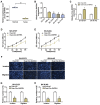A peptide encoded by the circular form of the SHPRH gene induces apoptosis in neuroblastoma cells
- PMID: 38282862
- PMCID: PMC10812589
- DOI: 10.7717/peerj.16806
A peptide encoded by the circular form of the SHPRH gene induces apoptosis in neuroblastoma cells
Abstract
Background: Circular RNAs (circRNAs) and their derived peptides represent largely unchartered areas in cellular biology, with many potential roles yet to be discovered. This study aimed to elucidate the role and molecular interactions of circSHPRH and its peptide derivative SHPRH-146aa in the pathogenesis of neuroblastoma (NB).
Methods: NB samples in the GSE102285 dataset were analyzed to measure circSHPRH expression, followed by in vitro experiments for validation. The role of SHPRH-146aa in NB cell proliferation, migration, and invasion was then examined, and luciferase activity assay was performed after SHPRH-146aa and RUNX1 transfection. Finally, the regulation of NB cell apoptosis by SHPRH-146aa combined with NFKBIA was tested.
Results: The GSE102285 dataset indicated overexpression of circSHPRH in NB samples, further supported by in vitro findings. Overexpression of circ-SHPRH and SHPRH-146aa inhibited proliferation, migration, and invasion of NB cells. A significant increase in apoptosis was observed, with upregulation of Caspase-3 and downregulation of Bcl-2. Furthermore, the peptide derivative SHPRH-146aa, derived from circSHPRH, suppressed NB cell malignancy traits, suggesting its role as a therapeutic target. A direct interaction between SHPRH-146aa and the transcription factor RUNX1 was identified, subsequently leading to increased NFKBIA expression. Notably, NFKBIA knockdown inhibited the pro-apoptotic effect of SHPRH-146aa on NB cells.
Conclusion: The study demonstrates that circ-SHPRH and SHPRH-146aa play significant roles in inhibiting the malignant progression of NB. They induce apoptosis primarily by modulating key apoptotic proteins Caspase-3 and Bcl-2, a process that appears to be regulated by NFKBIA. The SHPRH-146aa-RUNX1 interaction further elucidates a novel pathway in the regulation of apoptosis in NB. These findings indicate that circ-SHPRH and its derived peptide SHPRH-146aa could be potential therapeutic targets for NB treatment.
Keywords: Apoptosis; NFKBIA; Neuroblastoma; RUNX1; circSHPRH-146aa.
© 2024 Gao et al.
Conflict of interest statement
The authors declare that they have no competing interests.
Figures






Similar articles
-
Therapeutic SHPRH-146aa encoded by circ-SHPRH dynamically upregulates P21 to inhibit CDKs in neuroblastoma.Cancer Lett. 2024 Aug 28;598:217120. doi: 10.1016/j.canlet.2024.217120. Epub 2024 Jul 14. Cancer Lett. 2024. PMID: 39002691
-
Structural Characterization of the Hidden Peptide SHPRH-146aa Encoded by Non-Coding circ-SHPRH to Act as Tumor Suppressor.Appl Biochem Biotechnol. 2021 Jul;193(7):2076-2086. doi: 10.1007/s12010-021-03520-0. Epub 2021 Feb 9. Appl Biochem Biotechnol. 2021. PMID: 33559759
-
A novel protein encoded by the circular form of the SHPRH gene suppresses glioma tumorigenesis.Oncogene. 2018 Mar;37(13):1805-1814. doi: 10.1038/s41388-017-0019-9. Epub 2018 Jan 18. Oncogene. 2018. PMID: 29343848
-
The Emerging Role of Circ-SHPRH in Cancer.Onco Targets Ther. 2021 Jul 13;14:4177-4188. doi: 10.2147/OTT.S317403. eCollection 2021. Onco Targets Ther. 2021. PMID: 34285509 Free PMC article. Review.
-
Role of circular RNAs in retinoblastoma.Funct Integr Genomics. 2022 Dec 22;23(1):13. doi: 10.1007/s10142-022-00942-9. Funct Integr Genomics. 2022. PMID: 36547723 Review.
Cited by
-
Roles of small peptides encoded by non-coding RNAs in tumor invasion and migration.Front Pharmacol. 2024 Sep 16;15:1442196. doi: 10.3389/fphar.2024.1442196. eCollection 2024. Front Pharmacol. 2024. PMID: 39351098 Free PMC article. Review.
-
Peptidergic Systems and Neuroblastoma.Int J Mol Sci. 2025 Apr 8;26(8):3464. doi: 10.3390/ijms26083464. Int J Mol Sci. 2025. PMID: 40331938 Free PMC article. Review.
-
CircRNA and lncRNA-encoded peptide in diseases, an update review.Mol Cancer. 2024 Sep 30;23(1):214. doi: 10.1186/s12943-024-02131-7. Mol Cancer. 2024. PMID: 39343883 Free PMC article. Review.
-
Noncoding RNA-encoded peptides in cancer: biological functions, posttranslational modifications and therapeutic potential.J Hematol Oncol. 2025 Feb 19;18(1):20. doi: 10.1186/s13045-025-01671-9. J Hematol Oncol. 2025. PMID: 39972384 Free PMC article. Review.
References
-
- Aguilar-Mahecha A, Lafleur J, Brousse S, Savichtcheva O, Holden KA, Faulkner N, McLennan G, Jensen TJ, Basik M. Early, on-treatment levels and dynamic changes of genomic instability in circulating tumor DNA predict response to treatment and outcome in metastatic breast cancer patients. Cancers. 2021;13(6):1331. doi: 10.3390/cancers13061331. - DOI - PMC - PubMed
-
- De Hong C, Liang Ren L, Qiang W, Jia W, Ying Chun H, Lu Y, Zheng Hua L, Heng Ping L, Shi Bing Y, Yun Xiang L. Comparison of efficacy and safety of conventional laparoscopic radical prostatectomy by the transperitoneal versus extraperitoneal procedure. Scientific Reports. 2015;5:14442. doi: 10.1038/srep14442. - DOI - PMC - PubMed
MeSH terms
Substances
LinkOut - more resources
Full Text Sources
Medical
Molecular Biology Databases
Research Materials

